Slav Epic Part Four – Paintings 11 to 15
This post explores the detail on paintings numbered 11 to 15 in the Slav Epic series with interpretation, what to look for and historic context etc. If you want first to learn what leads up to the creation of the Slav Epic, who painted it, when and where it was painted, who owns it and where it is right now then check Slav Epic Part One.
Slav Epic Painting No.11: After the Battle of Vítkov, We Praise God to You (1916)
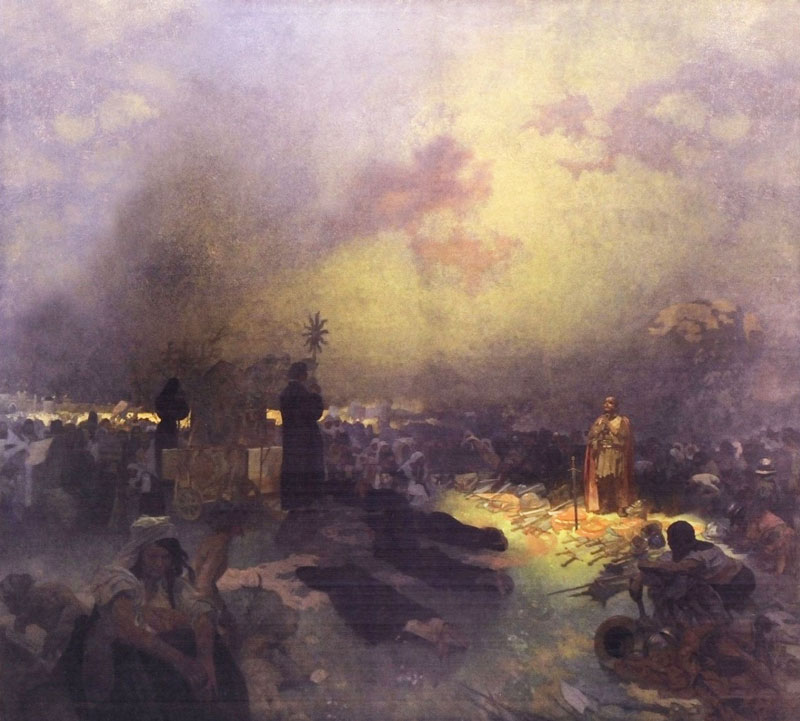
It’s 9 years later in the timeline and another Slav Epic post-battle scene at Vítkov in the present-day 3rd District of Prague. After the death of King Wenceslas IV, Emperor Sigismund begins a military offensive with German Teutonic help to capture Prague and has himself crowned King at Prague Castle. The Hussite peasant army now being led by General Jan Žižka arrives in Prague to do battle with the occupiers but finding themselves heavily outnumbered they form a defensive position at Vítkov Hill to battle the Imperial forces. With the battle finely balanced the city of Prague joins with the Hussites and together they defeat Sigismund forcing him to retreat first to Prague Castle and Vysehrad but later he’ll be ejected from the country.
It’s all about one man, Jan Žižka, held in the shaft of sunlight with the armour of the vanquished laid out in front of him. Facing him is a priest not with a chalice as you might expect in the Hussite faith but with a monstrance held before him indicating to Žižka that this victory is receiving the blessing of Christ himself. So the painting is basically saying that it is God’s will that the Hussites have achieved victory through Jan Žižka although notice that with a huge religious significance, Jan Žižka is shown standing, not kneeling.
Slav Epic Painting No.12: Petr of Čhelčice, Not to Repay Evil With Evil (1918)
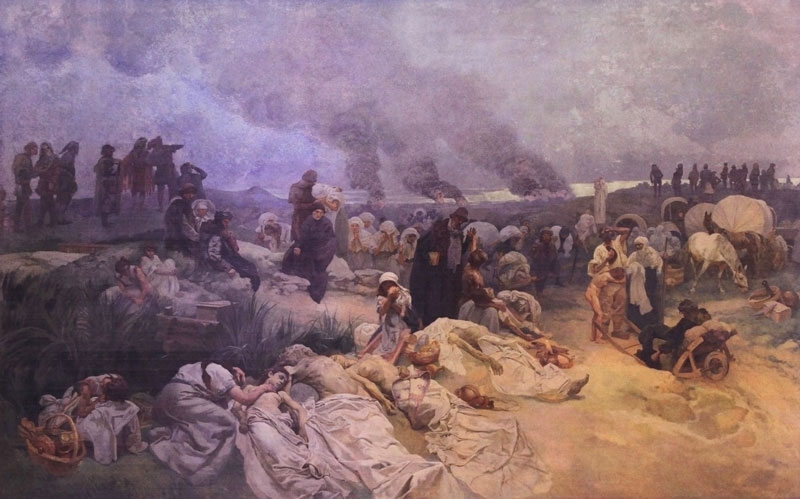
Although several of the Slav Epic paintings were completed during World War One, this painting is by far the most representative of Alfons Mucha and his desire to be a pacifist. Recognisable in any conflict, the inhabitants of a town (in this case a Royal town called Vodnany) attacked by Hussite forces have escaped to find some kind of sanctuary with their dead and injured in the neighbouring village of Čhelčice.
The man central in the painting is Petr of Čhelčice who walks among the suffering to provide comfort, to try and resolve these people’s feelings of anger and revenge. Set in the early 1430s also means that the period of the Hussite Wars is coming to an end. So there’s a direct link to the coming end of the First World War as Mucha is painting this one in 1918, he is preaching the Slavic ability to forgive and break the cycle of war rather than seek an eye for an eye.
Slav Epic Painting No.13: The Hussite King Jirí z Podebrad, King of Both People (1923)
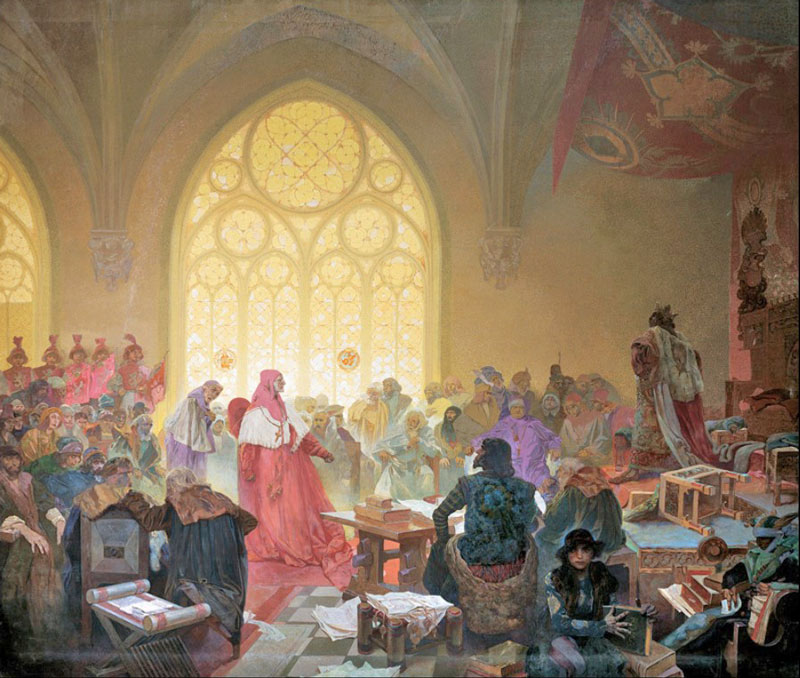
By “King of Both People” it’s referring to the fact that although he was also referred to as the “Hussite King”, he ruled with equal fairness over the Catholics and as in the previous painting, foreswearing vengeance. In the painting the main character and the reason for the work is standing on the right i.e. King George of Podebrad.
The painting is set in 1462 so the Czech nobility has elected one of it’s own (in fact the FIRST Czech King) but he still needs approval from the Pope. So we come to the second character of importance who is far more visible in the picture, Cardinal Fantimus de Valle who is having a profound disagreement with the new king who refuses to accept the Pope’s wishes to return to the Catholic Church rather than the Hussite Utraquist Church and therefore is not recognised by the Vatican. Mucha portrays the Cardinal in a more lit and central position to accentuate the power of the Vatican.
Centre-bottom-right of the painting a boy facing us closes a book entitled “Roma finita” meaning a break with Rome. It’s a powerful painting but historically within 9 years of this meeting George of Podebrad was dead and the Catholic Church had reasserted itself via a new Catholic King. Overall the painting is about the attempt to free the Slavs from the domination of the Vatican.
Slav Epic Painting No.14: The Defence of Sziget by Nikola Zrinski (1914)
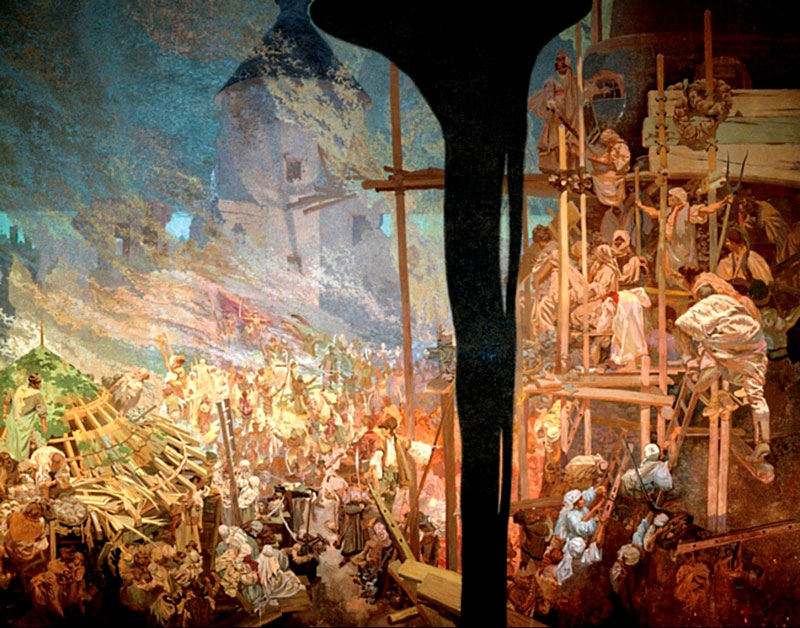
We move on from the Hussites to the Balkans and now the threat to the Slavs is coming from the Ottoman Empire and the Turks to the east. It’s 1566 and of the many sieges that take place the event that makes it to the Slav Epic is the Defence of Sziget, Hungary.
This event revolves around two characters i.e. the commander in the city called Nikola Zrinski and his wife but Mucha chooses not to display him in the painting. Instead he shows two timelines. On the right of the black line the people prepare their last defence of the city by putting tons of explosives into a tower. On the left, later in the battle is the aftermath of the last charge of Nikola Zrnski and his men resulting in their deaths. The Ottomans have demolished the outer wall and are now pouring into the city (look at the shape of the swords in the picture to spot the Ottomans).
Unbeknown to the invaders, the wife of Nikola Zrnski is seen on the scaffold top left and prepares to light the fuse which will ignite the explosives and devastate the city (some people interpret the black line as smoke from her already having lit the fuse). Although victorious, the battle and the later explosion cost the lives of more than 10,000 Ottomans including three generals and their overall commander plus it stopped the advance of the Ottoman Empire.
The painting depicts the “knowing sacrifice” as Nikola Zrnski knew he would die in the last attack and his wife knew that the explosion would likely kill her and many other Slavs but they were sacrificing themselves to protect their country and other Slavic Lands.
Slav Epic Painting No.15: The Printing of the Bible of Kralice, Fraternal School in Ivancice (1914)
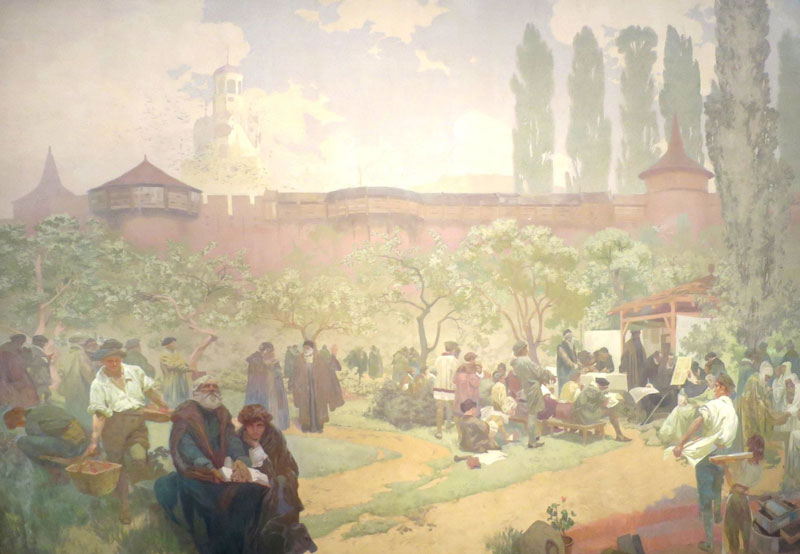
Here Mucha reinforces two previous pictures. The Brethren of Unity (or Church of the Brethren) was an outlawed religious group inspired by the pacifist teachings of Petr of Čhelčicky. They translated the New Testament into Slavic languages as was the desire of Jan Hus but they went a step further by also translating the Pentateuch (the frist five books of the Hebrew bible).
The Autumnal painting is set anytime between 1562 and 1578 in Ivančice which is coincidentally the birthplace of Alfons Mucha. I lean towards the 1578 end because the man in the arbor is supposed to be Jan of Zerotin who is checking the quality of the work. So why isn’t it called the Bible of Ivančice? well the presence of Jan of Zerotin signifies that the printed version of the Kralicka Bible that we have today was done 18km away in the fortified town of Kralice over which Jan of Zerotin ruled.
There is little else to interpret in the painting other than bottom-centre-left a boy appears to be reading some of the printed word to an old blind man but look carefully at the boy, he is actually looking at you and signifies the ongoing generational struggle. A detail showing a paper press is added bottom-right and birds are circling the white tower in the background signifying flight or escape. The Kralicka Bible is a National icon, the first wholly printed bible in Slavic language containing 6 volumes. It took 15 years to complete.
Previous: Slav Epic Paintings 6 to 10
Next: Slav Epic Paintings 16 to 20